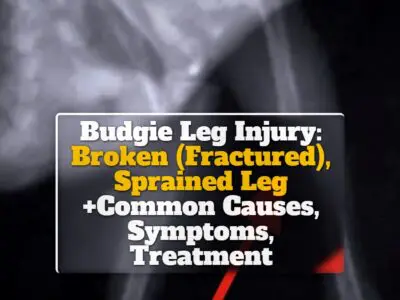Have you ever noticed your feathered friend’s beak growing a bit too long? Your budgie’s beak isn’t like our nails; it’s an essential part of their body, crucial to eating, playing, and even mobility.
In this guide, we’ll venture into the realm of overgrown budgie beaks, delve into the causes, explore the upper and lower beak differences, and more.
An overgrown beak in a budgie can be a sign of underlying health issues, improper diet, or injury.
The overgrowth can occur in both the upper and lower beak.
Trimming an overgrown beak should be done by a professional, as the beak is a sensitive area.
Preventive measures include providing a cuttlebone, mineral blocks, and chew toys.
What Is An Overgrown Beak? (With Pictures)
An overgrown beak is a phenomenon where the beak of a bird, in this case, a budgie, grows beyond the standard length.
This growth can occur both in the upper beak (rhinotheca) and the lower beak (gnathotheca).
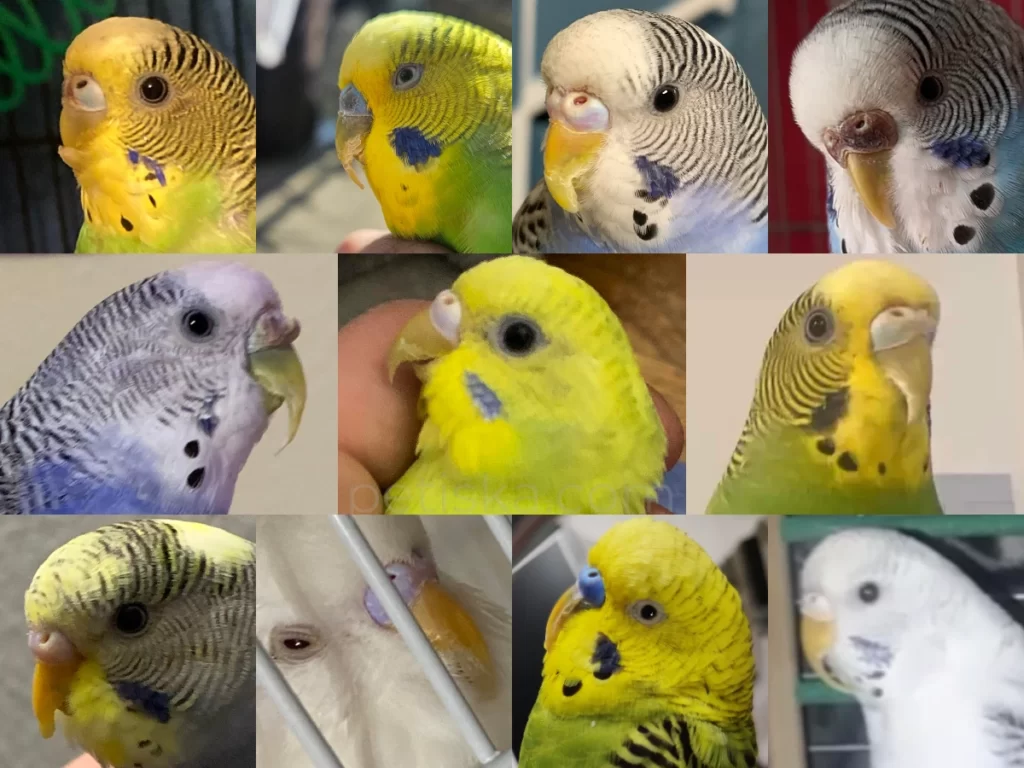
A budgie’s beak acts as a significant tool in their daily life, assisting in feeding, climbing, and even playing.
It should ideally have a smooth, symmetrical appearance, with the tip of the upper beak aligning with the lower beak’s curve.
Overgrowth disrupts this balance, often leading to severe functional difficulties.
Picture this: a straight, sleek beak transforming into a long, irregular, and possibly twisted formation.
That’s an overgrown beak for you.
Budgie Overgrown Upper Beak
When the upper beak or the rhinotheca of a budgie overgrows, it can start curling downwards, making a distinct hook.
This curvature might appear slightly charming but, on the contrary, can cause your feathered friend immense difficulty in feeding and preening.
Your bird might have to exert more effort to crack seeds or preen feathers, which can impact its overall health and happiness.
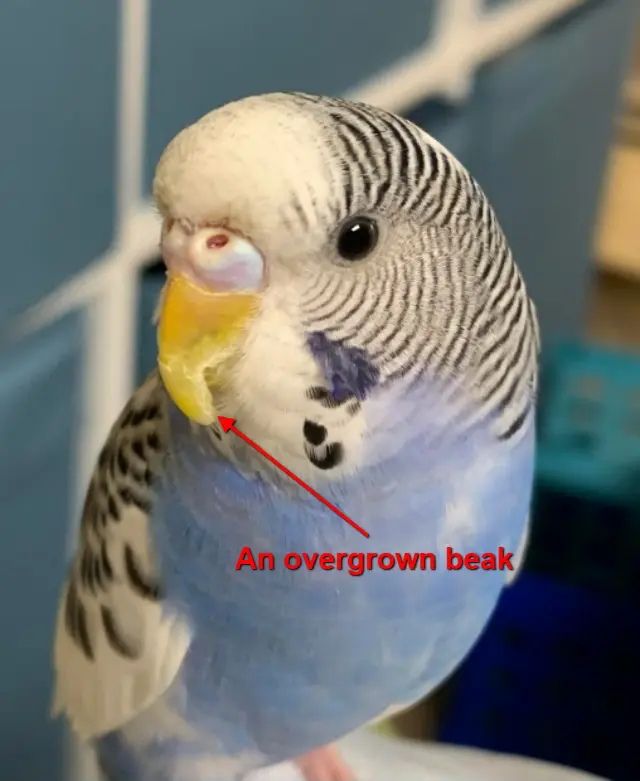
Budgie Overgrown Lower (Bottom) Beak
Though less common, the lower beak, known as the gnathotheca, can also overgrow.
If you observe a “misalignment” or an outward jutting of your budgie’s lower beak, it might be an overgrown lower beak case.
This scenario hinders the bird’s ability to close its mouth fully, leading to issues similar to an overgrown upper beak, with challenges in feeding and grooming.
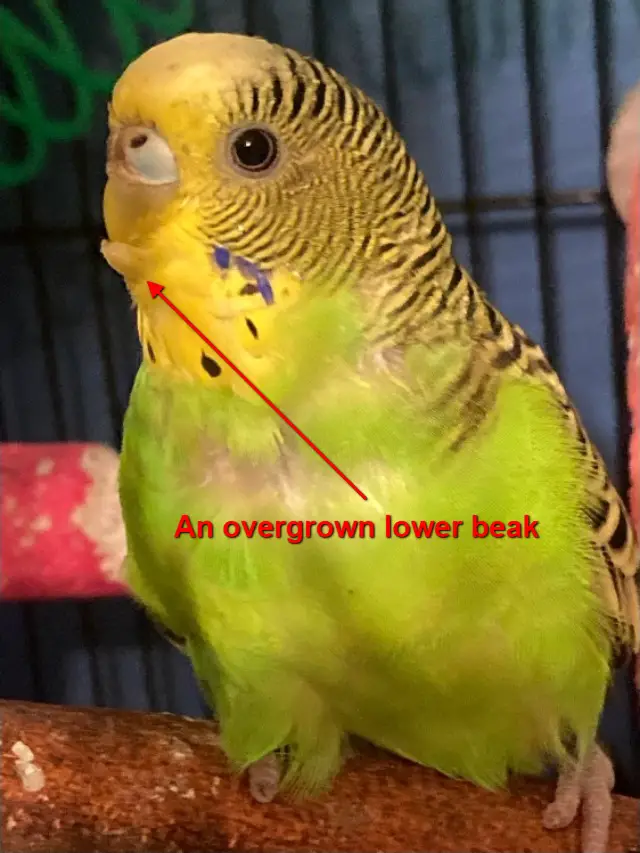
Why Do Beaks Overgrow?
The beak of a budgie, like the teeth in many mammals, grows continually.
Under normal conditions, activities like feeding, playing, and chewing on cuttlebones or wooden toys help to naturally wear down the beak, maintaining a healthy size and shape.
However, several factors can interfere with this process and cause overgrowth.
What Are The Common Causes Of An Overgrown Beak In Budgies?
An overgrown beak in budgies can result from various factors.
Understanding these causes can help in effective prevention and treatment.
One common cause of an overgrown beak is a lack of natural wear and tear.
In the wild, budgies naturally wear down their beaks through regular activities such as foraging for food, chewing on hard materials, and grooming.
However, in captivity, this natural wear and tear might not occur at the same rate, leading to potential overgrowth.
Another significant cause is an improper diet.
A diet deficient in essential nutrients can affect the beak’s overall health, causing abnormal growth.
For example, a lack of calcium can lead to a brittle beak that grows irregularly.
Underlying health conditions can also result in an overgrown beak.
Certain diseases, such as liver disease, can cause metabolic changes that affect beak growth.
Mites can also cause overgrowth by infesting and damaging the beak.
Genetic predispositions or congenital deformities might also contribute to beak overgrowth.
Some budgies might have a natural propensity towards an overgrown beak due to their genetic makeup.
Physical trauma or injury to the beak might also lead to overgrowth.
If a budgie’s beak is damaged or broken, the healing process might result in an overgrown or deformed beak.
What Can An Overgrown Beak Cause In Budgies?
An overgrown beak in budgies can have substantial adverse effects.
If left unattended, this condition can significantly disrupt the bird’s normal activities and overall well-being.
Firstly, a budgie uses its beak as a primary tool for eating.
An overgrown beak can interfere with the bird’s ability to properly grasp, manipulate, and ingest food.
This difficulty can result in poor nutrition, weight loss, and if not rectified, can lead to severe health issues like malnutrition.
Secondly, budgies use their beaks for preening – a critical part of their grooming routine.
They often run their feathers through their beaks to keep them clean and aligned correctly.
An overgrown beak can hinder this grooming process, leading to dirty or unkempt feathers, which in turn can affect the bird’s health and comfort.
Lastly, an overgrown beak can cause discomfort or even pain to the bird, especially if the overgrowth is severe or if the beak becomes deformed.
The discomfort might also result in behavioral changes, such as reduced activity, loss of appetite, or signs of stress.
Can My Budgie’s Beak Overgrow Even Though It Has A Cuttlebone Or Mineral Blocks?
Yes, it’s possible.
While cuttlebones and mineral blocks serve to provide necessary minerals and are a good source for naturally filing down the beak, they cannot prevent overgrowth due to underlying health issues or genetic factors.
It’s essential to keep a vigilant eye on your budgie’s beak condition even if these are present in its cage.
How To Treat An Overgrown Budgie Beak?
When a budgie’s beak overgrows, it’s crucial to address the issue promptly to prevent further complications.
Who Should Do The Beak Trimming Of Budgies?
Ideally, beak trimming should be performed by a qualified avian vet or a professional bird groomer.
They possess the expertise and the appropriate tools to trim the beak without causing harm to your budgie.
How To Trim An Overgrown Budgie Beak?
Trimming a budgie’s overgrown beak can seem daunting, but with the correct tools and steps, it’s possible to do this at home.
However, remember that this should only be attempted if professional veterinary care isn’t immediately available.
Here’s a detailed, step-by-step guide:
Step 1: Gather Necessary Materials
Before you begin, you’ll need a bird beak trimmer or a fine grit nail file, a towel, styptic powder (to stop any potential bleeding), a bird-safe disinfectant, and a flashlight.
Step 2: Create A Calm Environment
Choose a quiet, well-lit room to carry out the procedure.
This will reduce your budgie’s stress levels.
Step 3: Clean The Tools
Use a bird-safe disinfectant to clean your tools.
This will help prevent infection.
Step 4: Secure The Bird
Gently wrap your budgie in a towel, making sure its wings are secure.
This will help keep your bird calm and still during the procedure.
Step 5: Inspect The Beak
Use the flashlight to get a good look at the beak.
Note where the ‘quick’ (a blood vessel that runs down the beak) is located.
Step 6: Trimming
Begin to trim or file the overgrown part of the beak.
Be extremely careful not to touch the quick, as it can cause pain and bleeding.
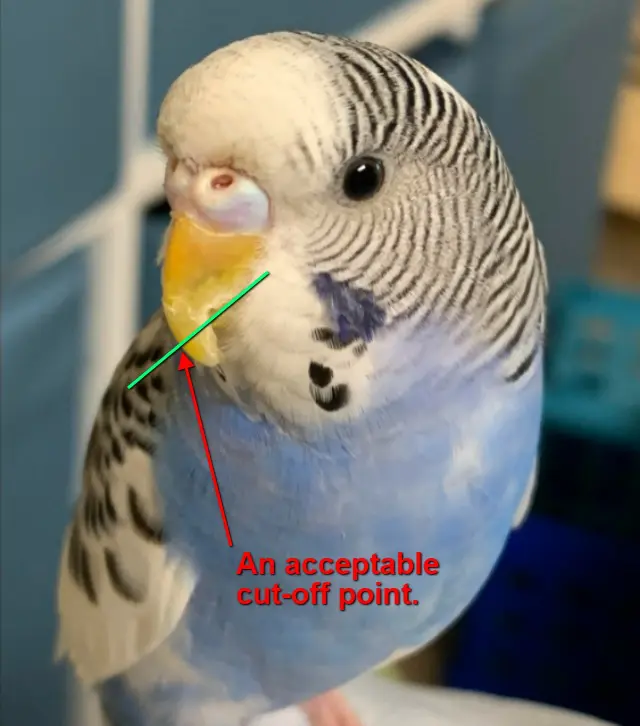
Step 7: Regular Pauses
Pause regularly during the trimming process to check your progress.
This helps prevent over-trimming.
Step 8: Soothe The Bird
Throughout the procedure, speak to your bird in a calm and soothing voice.
This will help keep it relaxed.
Step 9: Check For Bleeding
If you accidentally cause bleeding, apply styptic powder immediately and apply gentle pressure with a clean cloth until the bleeding stops.
Step 10: Aftercare
Once the procedure is complete, place your budgie back in its cage and observe its behavior.
If the bird seems distressed or in pain, contact a vet.
Is It Safe To Trim Budgie Beak?
Yes, it’s safe to trim a budgie’s beak if done by a professional.
It’s a routine procedure, much like trimming our own nails, but requires precision and expertise.
How Do You Trim A Budgie’s Beak At Home? Is It Safe To Trim Budgie Beak?
Although technically possible, it’s highly discouraged to trim your budgie’s beak at home.
The beak is a sensitive structure, and any misstep could lead to bleeding, pain, or even severe injury to the bird.
Always seek professional help when it comes to trimming a budgie’s beak.
How To Prevent Beak Overgrowth In Budgies?
While treating an overgrown beak is necessary, implementing measures to prevent such a situation is even more crucial.
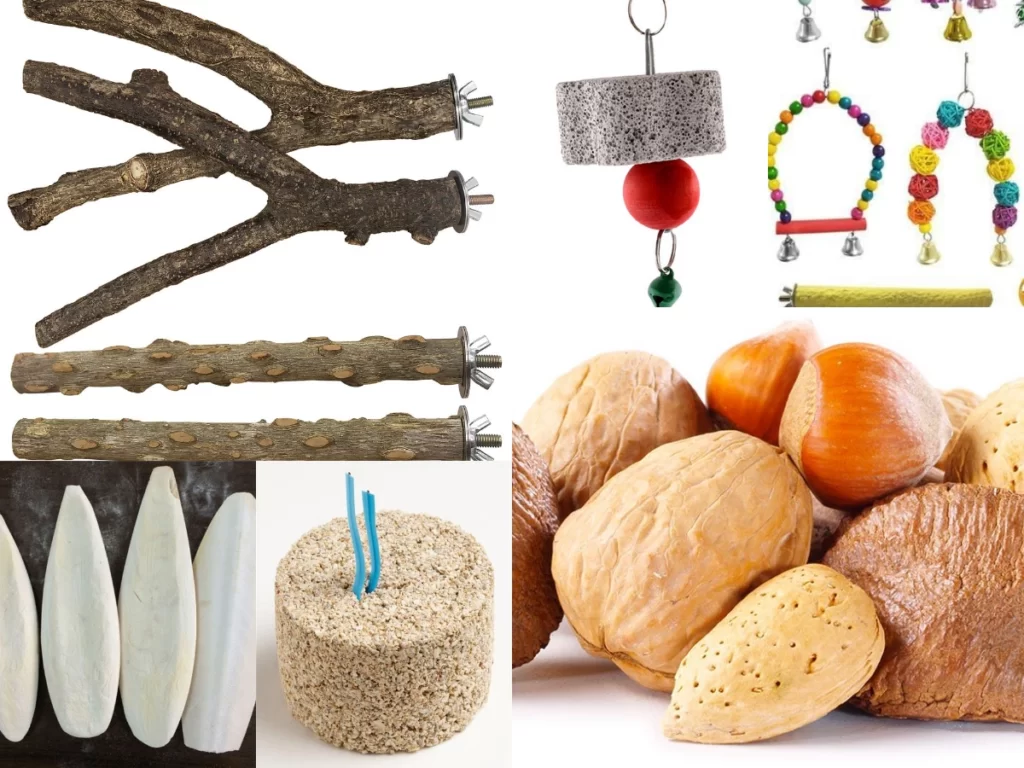
Let’s explore some tools that aid in naturally controlling beak growth:
Cuttlebone
A cuttlebone, a long, flat, white object, isn’t just a supplement high in calcium but also a natural file for your budgie’s beak.
Chewing on the cuttlebone allows your budgie to self-trim its beak.
Mineral Blocks
Similar to cuttlebones, mineral blocks provide necessary minerals to your budgie and offer an excellent means for natural beak trimming.
Natural Perches, Bird-safe Branches, Rope Perches
Introducing natural perches, bird-safe branches, or rope perches in the cage encourages the bird to chew, helping keep its beak in check.
Grinding stones (Pumice, Calcium Stones)
Grinding stones (pumice stones, calcium stones) are also effective in maintaining beak health.
Budgies enjoy gnawing at these stones, which can aid in naturally filing down their beaks.
Unshelled Nuts
Including unshelled nuts in your budgie’s diet allows them to exercise their beak, which can help prevent overgrowth.
Safe Chew Toys
Safe chew toys designed for birds can also promote natural wear and tear of the beak, thus averting excessive growth.
Faqs
As a budgie owner, you might have several queries about their beak health.
Let’s answer some common ones:
What Happens If A Budgie’s Beak Gets Too Long?
If a budgie’s beak gets too long, it can lead to difficulties in eating, grooming, and even discomfort while resting or sleeping.
If not addressed, over time, it can lead to malnutrition and severe health issues.
Do Budgies In Nature Also Have An Overgrown Beak?
In nature, budgies often wear down their beaks naturally through their regular activities, such as foraging for food or chewing on hard materials like wood.
However, it is still possible for a wild budgie to have an overgrown beak due to genetic factors, injury, or illness.
Do Baby Budgies Have An Overgrown Beak?
In general, baby budgies do not usually have an overgrown beak.
Like other birds, budgies are born with a soft, flexible beak that gradually hardens and takes its final shape as they grow.
However, if a baby budgie’s beak appears longer than normal, it might be due to genetic factors or health issues.
Overgrowth at such an early age is uncommon and may signal the need for professional intervention.
How Can I Detect An Overgrown Beak In My Budgie?
The first sign of an overgrown beak is a visible change in the beak’s length or shape.
If your budgie’s beak appears longer or starts curving unusually, it might be overgrown.
Additionally, if your budgie struggles to eat, preen, or shows discomfort while resting, it could indicate an overgrown beak.
Can Beak Overgrowth In Budgies Be A Sign Of Other Health Issues?
Yes, beak overgrowth can sometimes signal underlying health issues, such as liver disease or mite infestation.
These conditions can affect the normal growth and health of the beak, leading to overgrowth.
Hence, if you notice an overgrown beak, it’s best to consult an avian veterinarian for a comprehensive health check.
What Should I Do If I Suspect My Budgie’s Beak Is Overgrown?
If you suspect your budgie’s beak is overgrown, the best course of action is to consult with a qualified avian veterinarian.
They can assess the beak’s condition and provide appropriate treatment options, which might include professional beak trimming or addressing underlying health conditions.
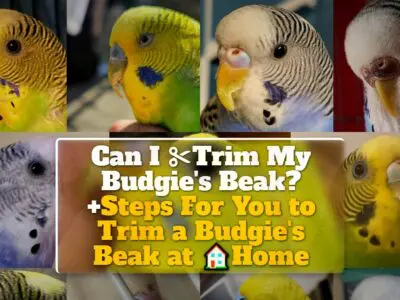
![New Budgie’s First Days at Home & Behavior [What to Do?]](https://www.petiska.com/wp-content/uploads/2022/05/new-budgies-first-days-at-home-behavior-what-to-do-1653309166-400x300.jpg)
